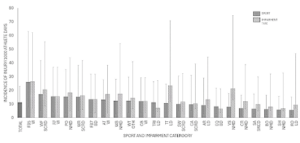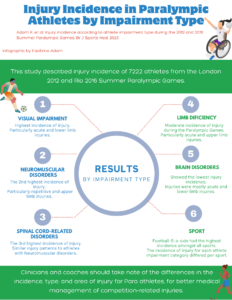Key words: Impairment, Para Sport, Injury, Paralympics, Summer, Para athlete
Injury surveillance in Para sport is an important part of Para athlete medical management. The underlying impairment type of each Para athlete requires an impairment-specific approach in order to successfully manage injuries. This blog summarises a recent publication investigating the incidence of injury according to athlete impairment type during the London 2012 and Rio 2016 Summer Paralympic Games, by sex, age, pre-vs competition period, and injury type, to inform bespoke injury management for Para athletes with different impairments (1).
Why is this study important?
The profiles of sport-related injuries in the Para sport population have been studied in and out of competition (2-9). However, studies investigating impairment-related injury risk factors are limited.
Understanding the intricate relationship between an athlete’s impairment type, their sport discipline, and equipment utilisation is important. This study represents a pioneering effort as the largest impairment-specific investigation of Para athlete injuries to date. Results may contribute towards improving the quality of Para athlete research and injury prevention, comprising initial strides toward impairment-specific health management in Para sport.
How did the study go about this?
The injury data collected during the London 2012 and Rio 2016 Summer Paralympic Games were combined to form a database of 7222 athletes. Internet sources were used to identify the impairment types of all athletes that participated at the Games. To identify an athlete’s likelihood of sustaining an injury, injury rates and proportion were reported according to injury incidence per 1000 athlete days. Injury rates were reported for nine different impairment categories according to risk factors of: age (12–25 years, 26–34 years and 35+ years), sex (male or female), Games period (pre- vs competition), injury type (acute, repetitive, or gradual injuries) and area of injury (head, face and neck (HFN), upper limb (UL) mid-thoracic or lower limb (LL)). The impairment types of athletes were categorised according to athletes with brain disorders (BD), limb deficiency (LD), neuromuscular disorders (NMD), spinal cord-related disorders (SCRD), visual impairment (VI) and ’all others’ (OTH: impaired passive range of movement, intellectual impairment, leg length difference, short stature, and unidentifiable impairments).
What did the study find?
During the London 2012 and Rio 2016 Summer Paralympic Games, the incidence and type of injuries differed between athlete impairment types. Athletes with visual impairment had the highest incidence of injury, followed by athletes with neuromuscular disorders and spinal-cord related disorders. Athletes with limb deficiency had a moderate injury incidence, whilst athletes with brain disorders had the lowest incidence of injury. Acute injuries and injuries to the lower limb were common amongst athletes with visual impairment, while athletes with neuromuscular disorders had a higher incidence of repetitive injuries and injuries to the upper limb. In terms of sport, the athlete impairment category with the highest incidence of injury differed per sport (Figure 1).

Figure 1: Incidence of injury by impairment type
What are the key take-home points?
Para athletes represent a heterogeneous athlete population group and managing the health of a Para athletes requires consideration of their underlying impairment type. During Summer Paralympic Games, athletes with visual impairment or neuromuscular disorders may be more susceptible to sustaining an injury compared to athletes of other impairment types. Clinicians and coaches should take note of the differences in the incidence, type, and area of injury for Para athletes with different impairment types, for better medical management of competition-related injuries in Para athletes.

Authors: Faatima Adam (1) and Phoebe Runciman (1)
(1) Institute of Sport and Exercise Medicine (dISEM), Department of Exercise, Sport, and Lifestyle Medicine, Faculty of Medicine and Health Sciences, Stellenbosch University.
References
- Adam F, Derman W, Schwellnus M, et al Injury incidence according to athlete impairment type during the 2012 and 2016 Summer Paralympic Games: a combined analysis of 101 108 athlete days British Journal of Sports Medicine Published Online First: 29 January 2024. doi: 10.1136/bjsports-2023-107144
- Fagher, K, and J Lexell Sports-related injuries in athletes with disabilities Scandinavian Journal of Medicine & Science in Sports vol. 24,5 (2014): e320-31. doi:10.1111/sms.12175
- Pinheiro LS, Ocarino JM, Madaleno FO, et al Prevalence and incidence of injuries in para athletes: a systematic review with meta-analysis and GRADE recommendations British Journal of Sports Medicine. Published Online First: 1 December 2021. doi:10.1136/bjsports-2020-102823
- Derman W, Schwellnus M, Jordaan E, et al Illness and injury in athletes during the competition period at the London 2012 Paralympic Games: Development and implementation of a web-based surveillance system (WEB-IISS) for team medical staff British Journal of Sports Medicine. 2013;47(7):420-425. doi:10.1136/bjsports-2013-092375
- Fagher, Kristina et al The Sports-Related Injuries and Illnesses in Paralympic Sport Study (SRIIPSS): a study protocol for a prospective longitudinal study BMC Sports Science, Medicine & Rehabilitation Published Online First: 30 August 2016. doi:10.1186/s13102-016-0053-x
- Hirschmüller, Anja et al Injury and Illness Surveillance in Elite Para Athletes: An Urgent Need for Suitable Illness Prevention Strategies American Journal of Physical Medicine & Rehabilitation vol. 100,2 (2021): 173-180. doi:10.1097/PHM.0000000000001501
- Steffen, Kathrin et al Illness and injury among Norwegian Para athletes over five consecutive Paralympic Summer and Winter Games cycles: prevailing high illness burden on the road from 2012 to 2020 British Journal of Sports Medicine vol. 56,4 (2022): 204-212. doi:10.1136/bjsports-2021-104489
- Brownlow, Michael et al Year-round injury and illness surveillance in UK summer paralympic sport athletes: 2016-2019 British Journal of Sports Medicine Pusblished Online First: 13 March 2024. doi:10.1136/bjsports-2023-107219
- Luijten SCM, Nauta J, Janssen TWJ, et al Occurrence of injuries and illnesses in athletes with a physical impairment; a forty-week prospective cohort study. Journal of Science and Medicine in Sport 2024;27(3):160-165. doi:10.1016/j.jsams.2023.11.01